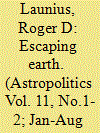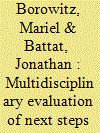| Srl | Item |
| 1 |
ID:
122526


|
|
|
|
|
| Publication |
2013.
|
| Summary/Abstract |
What if we viewed the history of human spaceflight somewhat less through the lens of Cold War politics, which admittedly was central to the race to the Moon, but more as an expression of what might be called a religion of spaceflight? There seems to be a deeply religious quality to advocacy for the investment in and support for human space exploration, lending to the endeavor of a "higher purpose" that helps to explain both the generous nature of the actual investment and the ultimate unwillingness of Americans to eviscerate space budgets despite less than full support for space exploration. This article examines religious conceptions as a means of analyzing what might be termed a "space gospel." I lay out here the proposition that human spaceflight may be viewed as a religion with similar attributes to those present in mainstream religious denominations. This approach to exploring the history of human spaceflight offers a different and useful frame of understanding that broadens basic conceptions about this aspect of the human past.
|
|
|
|
|
|
|
|
|
|
|
|
|
|
|
|
| 2 |
ID:
111257


|
|
|
|
|
| Publication |
2012.
|
| Summary/Abstract |
As international partnerships increasingly look to be the way forward for sustainable human space exploration, the need to think about language protocols becomes more pressing. Using the historical examples of three international human spaceflight missions, this viewpoint shows how each language protocol was dictated by political realities and how often difficulties arose during implementation as a result. It is argued that, in order to optimize operational environments in future human space exploration, the international space community should adopt a standardized, single-language protocol, similar to commercial aviation. While English may appear to be the most obvious candidate, other languages, particularly Russian and perhaps even Chinese, may also be worth considering.
|
|
|
|
|
|
|
|
|
|
|
|
|
|
|
|
| 3 |
ID:
147519


|
|
|
|
|
| Summary/Abstract |
There is a growing consensus among stakeholders around the world that the long-term objective of human space exploration is the long-duration presence of humans on the surface of Mars. However, the key question concerns the choice of near-term missions that will bridge current human spaceflight activities in low Earth orbit (LEO) and eventual Mars exploration. This paper contributes to this debate by identifying the scope of possible near-term missions, arguing that there are only four realistic proposals for initial human exploration beyond low Earth orbit: a cis-lunar habitat, asteroid redirect, Mars flyby, and a short lunar surface sortie. The paper then evaluates these missions across five criteria: 1) technical/economic feasibility, 2) contribution to the eventual goal of exploring Mars, 3) potential for international cooperation, 4) global readiness for the mission, and 5) political feasibility to establish a clear assessment of the pros and cons of each of these four missions. While recognizing that any one of these missions represents a feasible option for future human space exploration, we recommend that the international community pursue development of a cis-lunar habitat as its immediate goal. This mission maximizes development of technology necessary for Mars exploration, provides significant opportunities for meaningful international participation, and could be achieved on a reasonable schedule with current budgets. Both the asteroid redirect mission and lunar exploration plans have the potential to benefit from the development of a cis-lunar habitat and could be retained as intermediate or parallel missions, as resources allow.
|
|
|
|
|
|
|
|
|
|
|
|
|
|
|
|